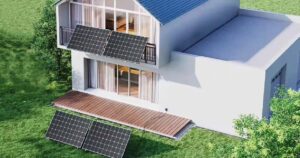

The highly anticipated Paris 2024 Olympics will start in just 1 day! Scheduled from July 26 to August 11.
Why is this Olympic Games extremely awaited? The most important reason is the sustainable energy it adopts. To save energy and respond to the goal of carbon neutrality, Paris is making remarkable efforts toward sustainability, and solar power is taking center stage. Now, let’s take a look at where this new type of green, environmentally friendly, money- and energy-saving technology has been adopted.
The Aquatics Centre
A Solar-Powered Marvel in Paris 2024 Olympics


To respond to environmental protection, 95% of the venues have been renovated from the old ones. Among them, is the only brand-new competition venue The Aquatics Centre. The Aquatics Centre serves as a remarkable example of sustainable design. Not only is it powered by solar energy, but it also utilizes natural bio-based building materials and recycled ones. France’s power mix already has a relatively low carbon intensity. However, the electricity used for the Olympics will undergo further decarbonization thanks to the solar rooftop on the Games’ swimming pool, which is France’s largest urban solar PV array.


The timber structure and roof frame of the building are ingeniously designed to blend seamlessly with the surrounding greenery. The 4,680-square-meter rooftop, covered with photovoltaic panels, ensures it can generate all the energy it needs. This makes the swimming pool one of the largest urban solar farms in France. Moreover, all the seats in the centre are made from recycled local plastic waste. Wood plays a central role in construction, helping to reduce construction emissions.
The Athletes’ Village
New Energy Sources in Paris 2024 Olympics
The Athletes’ Village is not lagging in the sustainable energy race. It generates energy from various sources like geothermal and solar power. 1/3 of the rooftops are equipped with solar panels. Thoughtful design elements like gardens and wind tunnels formed by the Seine between the buildings help regulate the temperature.


The Athletes’ Village bus station is well-protected from both the sun and the various elements. It’s roof features an impressive 800m² of flexible solar panels, which are set to supply power to the Team Processing Centre. The shading structure is capable of generating 110kWc of electricity. As a result, it is able to cover approximately 25% of the electricity requirements of this structure that is specifically reserved for the reception and information purposes of the international delegations of athletes. All of this power usage is through auto-consumption.

But surprisingly, there are no air conditioners in the Athletes’ Village. Perhaps it’s because the average temperature in Paris in July and August is generally around 25 degrees Celsius, and the host country believes that geothermal cooling is sufficient to achieve the cooling effect. However, teams like the United States and China will provide air conditioning facilities for their athletes.


Solar Farms
Floating on the Seine During the Paris 2024 Olympics
On the River Seine, a floating solar farm steals the spotlight. With its 400m² of photovoltaic surface area, this mobile, floating, and removable installation can produce 78kWc of electricity. It’s equivalent to the consumption of about 94 apartments in the Olympic and Paralympic Village.




EDF’s Contribution
Certifying Green Power During the Paris 2024 Olympics
State power company EDF is exerting a significant influence by providing the Games with guarantees of origin (GOs). This attests that green power equivalent to the Games’ consumption has been fed into the grid from wind and solar farms in France. The emphasis on solar power at the Paris 2024 Games accentuates its significance and efficacy. It establishes a compelling precedent for major events worldwide to follow in the quest for a greener future.
“After the Paris 2024 Games, EDF will be able to supply 100% renewable electricity for temporary connections utilizing GOs for the first time. This is a major stride towards the decarbonization of special events,” stated Birgit Fratzke-Weiss, the commercial director of EDF for the Ile-de-France region.
You may also be interested in the pages below
- Alibaba – Gidita Life
- Ecer – Gidita Solar
- Amoy Brand – Gidita Solar
- Gidita Solar
- Solar System & Application FAQs
- Distinction Between Off-Grid, On-Grid, and Hybrid Solar System? No More Confusion, all in 1 Basic Article!
- 6 Types of Solar Water Pumps Systems – Powerful Irrigation And Water Supply?
- Why Balcony Solar Systems Become Booming All the World? Your Balcony can be a 100% Powerful Energy Hub!
- Are Solar Air Conditioners Any Good? Revolutionary Energy-Saving More than 99% Air Conditioning System


Xiamen Geno Industry Co,. Ltd.
Tel / WhatsApp: +86 13906057667
Email: cathy@geno-china.com
